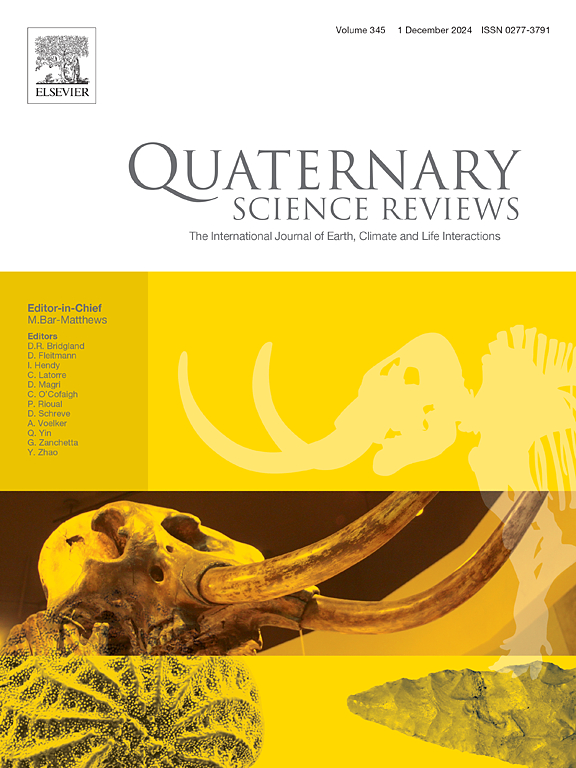Environmental changes reflected by sedimentary records of detrital minerals in the eastern Laptev Sea over the past 12 kyrs
IF 3.2
1区 地球科学
Q1 GEOGRAPHY, PHYSICAL
引用次数: 0
Abstract
The Siberian Arctic shelf is important for sediment transport and deposition, shaped by complex interactions among river input, permafrost erosion, and sea ice processes. Despite advances in understanding these systems, the sedimentary evolution of the eastern Laptev Sea shelf over the Late Pleistocene, and its response to sea-level and climate changes, remains unclear. Here, we analysed light and heavy minerals, coarse components and sediment smear slide estimations from a sediment core collected on the paleo-floodplain of the Yana and Lena rivers, compared them with surface sediments. The results reveal four distinct sedimentary periods: (1) a river floodplain phase (∼12–10.4 ka BP), characterized by fluvial deposits rich in micas, limonite, quartz, and plagioclase; (2) a fine-grained, organic-rich phase linked to permafrost erosion and/or island flattening under warmer climate conditions and rapid sea level rising (∼10.4–8.2 ka BP), with abundant authigenic barite, pyrite, and siderite; (3) a peak fluvial input phase during continuous sea level rise (∼8.2–5.0 ka BP), marked by increased volcanic glass and initially intensified sea ice; (4) the modern sedimentary regime (∼5.0–0 ka BP), with decreased fluvial input and strengthened sea ice transport. Since ∼2 ka BP, increased silt content indicates that more sediment originates from anchor ice on the shelf. Variations in detrital minerals, such as hypersthene, suggest sediment contributions from the western Laptev Sea, Lena, Khatanga, and Anabar Rivers, and even the Taymyr Peninsula and Kara Sea, indicating an eastward shift in the Transpolar Drift System.
拉普捷夫海东部近12年碎屑矿物沉积记录反映的环境变化
西伯利亚-北极陆架是河流输入、永久冻土侵蚀和海冰过程之间复杂的相互作用形成的沉积物运输和沉积的重要区域。尽管对这些系统的了解有所进展,但拉普捷夫海东部陆架晚更新世的沉积演化及其对海平面和气候变化的响应仍不清楚。在这里,我们分析了从雅纳河和勒拿河古洪泛平原收集的沉积物岩心的轻矿物和重矿物、粗组分和沉积物涂抹滑动估计,并将其与地表沉积物进行了比较。结果揭示了四个不同的沉积时期:(1)河流漫滩期(~ 12-10.4 ka BP),以富含云母、褐铁矿、石英和斜长石的河流沉积为特征;(2)在气候变暖和海平面快速上升(~ 10.4-8.2 ka BP)的条件下,与多年冻土侵蚀和/或岛屿变平有关的细粒富有机质阶段,具有丰富的自生重晶石、黄铁矿和铁铁矿;(3)海平面持续上升期间(~ 8.2 ~ 5.0 ka BP)的河流输入高峰期,以火山玻璃增加和海冰初始强化为标志;(4)现代沉积期(~ 5.0 ~ 0 ka BP),河流输入减少,海冰输送增强。自~ 2 ka BP以来,泥沙含量的增加表明更多的沉积物来自陆架上的锚冰。碎屑矿物的变化,如超细颗粒,表明来自拉普捷夫海西部、勒拿河、哈坦加河和阿纳巴尔河,甚至是泰米尔半岛和喀拉海的沉积物贡献,表明跨极漂移系统向东移动。
本文章由计算机程序翻译,如有差异,请以英文原文为准。
求助全文
约1分钟内获得全文
求助全文
来源期刊

Quaternary Science Reviews
地学-地球科学综合
CiteScore
7.50
自引率
15.00%
发文量
388
审稿时长
3 months
期刊介绍:
Quaternary Science Reviews caters for all aspects of Quaternary science, and includes, for example, geology, geomorphology, geography, archaeology, soil science, palaeobotany, palaeontology, palaeoclimatology and the full range of applicable dating methods. The dividing line between what constitutes the review paper and one which contains new original data is not easy to establish, so QSR also publishes papers with new data especially if these perform a review function. All the Quaternary sciences are changing rapidly and subject to re-evaluation as the pace of discovery quickens; thus the diverse but comprehensive role of Quaternary Science Reviews keeps readers abreast of the wider issues relating to new developments in the field.
 求助内容:
求助内容: 应助结果提醒方式:
应助结果提醒方式:


